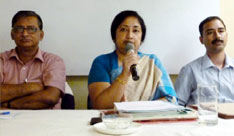Recognize STROKE yourself
What is a transient ischemic attack (TIA)?
Some people call a transient ischemic attack (TIA) a mini-stroke, because the symptoms are like those of a stroke but don't last long. A TIA happens when blood flow to part of the brain is blocked or reduced, often by a blood clot. After a short time, blood flows again and the symptoms go away. With a stroke, the blood flow stays blocked, and the brain has permanent damage.
A TIA is a warning: it means you are likely to have a stroke in the future. Early treatment can help prevent a stroke. If you think you have had a TIA but your symptoms have gone away, you still need to call your doctor right away.
What are the symptoms?
Symptoms of a TIA are the same as symptoms of a stroke. But symptoms of a TIA occur suddenly and don't last very long. Most of the time, they go away in 10 to 20 minutes. They may include:
• Sudden numbness, tingling, weakness, or paralysis in your face, arm, or leg, especially on only one side of your body.
• Sudden vision changes.
• Sudden trouble speaking.
• Sudden confusion or trouble understanding simple statements.
• Sudden problems with walking or balance.
• A sudden, severe headache that is different from past headaches.
What causes a transient ischemic attack?
A blood clot is the most common cause of a TIA. Blood clots can be the result of hardening of the arteries (atherosclerosis), heart attack, or abnormal heart rhythms. Brain cells are affected within seconds of the blockage. That causes symptoms in the parts of the body controlled by those cells. After the clot dissolves, blood flow returns, and the symptoms go away.
Sometimes a TIA is caused by a sharp drop in blood pressure that reduces blood flow to the brain. This is called a "low-flow" TIA. It is not as common as other types.
What tests do you need after a TIA?
Your doctor will do tests to look at your heart and blood vessels. You may need:
• Tests that show pictures of your brain and blood vessels, such as a CT scan, an MRI, a magnetic resonance angiogram (MRA), or an angiogram.
• A test that uses sound to check your blood flow (Doppler ultrasound).
• An echocardiogram (echo) to check your heart's shape and its blood flow.
• An electrocardiogram (EKG, ECG) to measure your heart rhythm.
• Blood tests, including a complete blood count and a fasting blood test to check for problems that could be causing your symptoms.
Role of caregivers:
Caregivers/family members play a prominent role throughout the post-stroke recovery process. Caregivers/family members are essential to successful home care and too often are ignored. Caring for stroke survivors at home can cause high levels of emotional, mental and physical stress. In addition to distress, disruption of employment and family life makes care giving very challenging. Family caregivers can promote positive post-stroke recovery outcomes; however, they need to care for themselves as well. Post-stroke recovery varies for each person; even if the stroke survivor returns to work and maintains a large amount of autonomy, family members may play a bigger role in the stroke survivor’s live than before the stroke.
Caregivers/family members of stroke survivors: You are not alone.
Caregivers/family members may:
• Assist with doctor’s appointments, medications, and exercises.
• Manage financial matters and transportation.
• Provide the stroke survivor with physical, mental and emotional support.
• Assist the stroke survivor with daily activities such as personal care and hygiene.
• Plan out the stroke survivor’s care, including setting routines and managing the care team.
• Assess stroke survivor’s medical needs, communicate with healthcare professionals and advocate (medically) for the stroke survivor.














